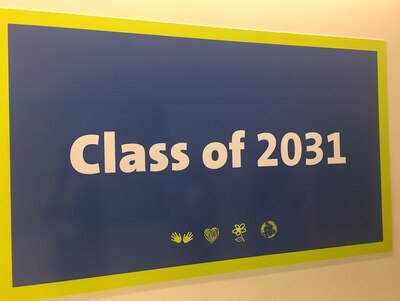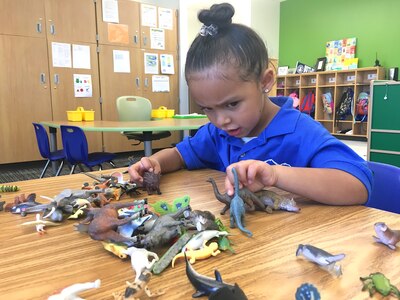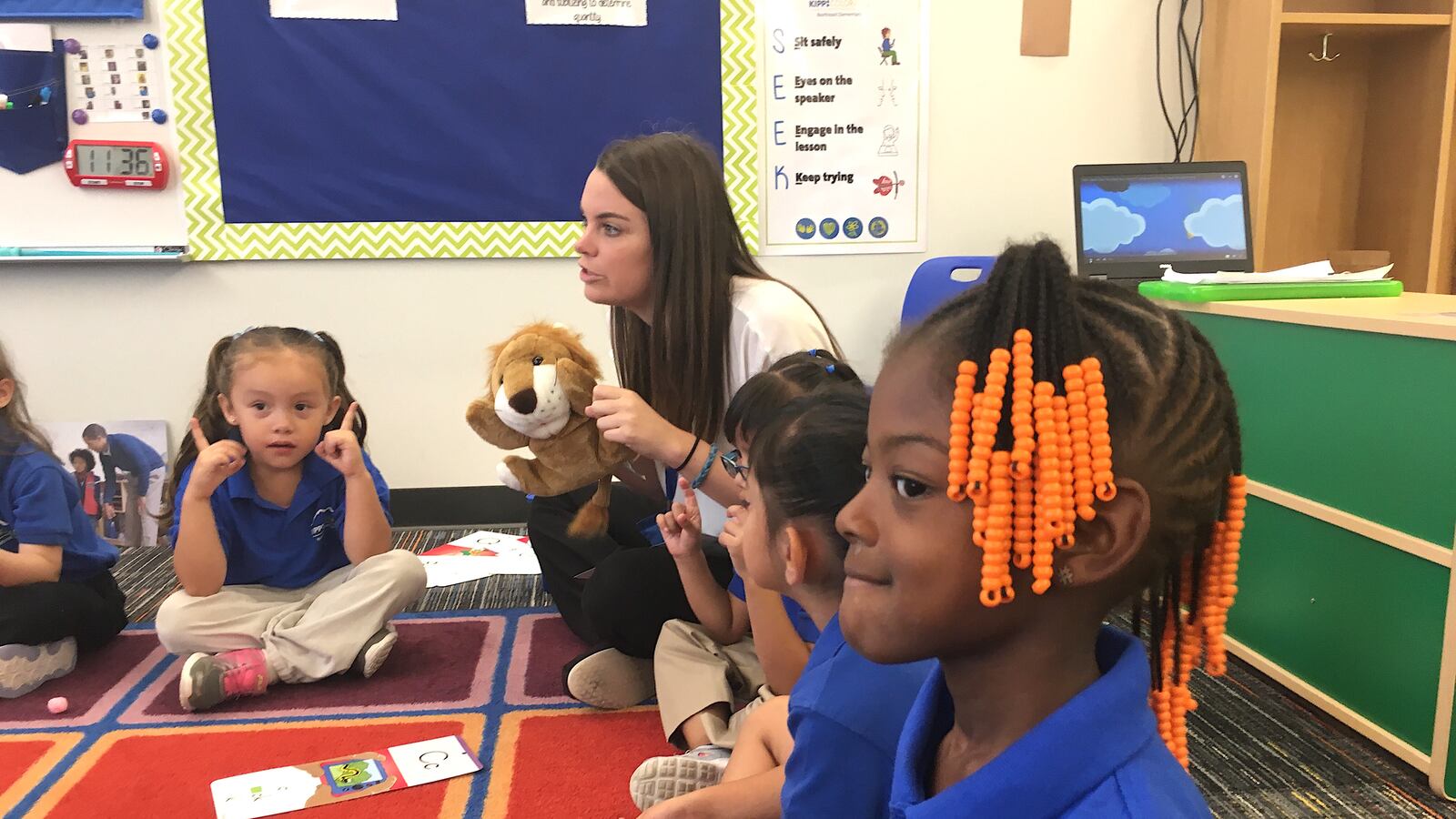In many ways, the new preschool in Denver’s growing Green Valley Ranch neighborhood looks like any other preschool.
At playtime, a little girl trots toy dinosaurs across a table heaped with plastic animals. Nearby, a 4-year-old boy shows off a picture he drew with lots of red scribbles and dots. There is the usual collection of books, tiny plastic chairs and colorful rugs.
There are also telltale signs that the preschool is run by KIPP, one of the country’s largest college prep charter school networks. The classrooms are all named for colleges, like in KIPP’s higher grades. The preschoolers wear blue polo shirts emblazoned with the school’s logo. A crisp blue banner in the hallway proclaims them the “Class of 2031.”
Across Denver, a growing number of preschoolers are getting their first dose of formal education at charter schools that have retrofitted their models to meet the needs of younger students. The trend is fueled by a growing awareness that getting kids in the door early pays off later academically and by a hunger among parents for affordable, high quality preschool options.
It also signals charter leaders’ increasing willingness to navigate the complicated — and often unfamiliar — early childhood funding and regulatory landscape.
At least six Denver charter schools, most serving large low-income populations, have launched preschool programs in the last five years. Besides KIPP — which enrolls 48 preschoolers at its Northeast Elementary School — they include two locations of Rocky Mountain Prep, Highline Academy’s school in Green Valley Ranch, Academy 360 in Montbello and REACH Charter School in central Denver. (A couple charter schools offered preschool even earlier, but have since closed.)
There’s little dispute about the need for more quality preschool programs. Several neighborhoods in Denver, including parts of Montbello and Green Valley Ranch, are considered “child care deserts” because of the dearth of licensed preschool and child care slots, according to a recent report from the Center for American Progress.

Lindsey Lorehn, the school leader at KIPP Northeast Elementary, said when the school first opened in a smaller location with kindergarten and first grade in 2015, “What we heard pretty resoundingly from families was they wanted a high quality early childhood education program.”
The school’s new building, nestled among recently built homes in Green Valley Ranch, made that possible. Its three preschool classrooms opened this fall, just as a highly regarded child care center in the same neighborhood was closing its doors. There already are 41 children on KIPP’s preschool waitlist.
Rocky Mountain Prep, which offers preschool to both 3- and 4-year-olds, has more than 150 children on waitlists for a spot at one of its two Denver schools and about 30 children on the waitlist at its newest school in Aurora.
Of the six charter-run preschool programs in Denver, four have Level 3 or 4 ratings, markers of quality under state’s child care rating system. Like other new preschools, KIPP’s program has the lowest Level 1 rating, which means it’s licensed but hasn’t yet gone through the lengthy process required for a higher rating. Leaders there hope to reach Level 3 by next year.
While preschool programs run by charter schools aren’t new, experts say they make a lot of sense educationally — with one major caveat. They must be developmentally appropriate and not overly academic. In other words, plenty of play and lots of time devoted to social-emotional skills. No rote memorization, drill-and-kill tactics or long sit-down lessons.
“There’s no doubt you’re gonna get better outcomes if you start with those children at a younger age,” said Geoffrey Nagle, president and CEO of the Erikson Institute, a Chicago graduate school focused on child development.
Many charter schools initially launched with a K-5 or K-8 structure mainly because of the way school funding was allocated, he said. Their leaders later realized, “We have to go upstream and get these kids earlier.”
Nationwide, the prevalence of charters with preschool programs varies by state.
In Colorado, 33 of 149 charter schools that include elementary grades, or 22 percent, offered preschool last year, according to state education department officials.
Figuring out how to pay for preschool is one of the challenges for Colorado schools, charter or otherwise. The state funds some preschool slots for at-risk children, but most are half-day spots and there’s not enough to meet demand. There’s also limited state funding for preschoolers with special needs.

A 2015 report from the Fordham Institute designated Colorado as offering charters that wanted to provide preschool a “somewhat hospitable” climate — the middle of three ratings. The state was dinged for its relatively low level of state preschool funding and because most charter schools have to seek the funding through their authorizing districts, which the report authors described as a barrier.
But it’s not a problem in every district. State officials say Denver Public Schools is exemplary when it comes to sharing state preschool funding with charter schools and community-based providers.
Even so, Denver charter schools that offer preschool usually have to cobble together dollars from lots of sources — the state, the city, the school district and in-house fundraising. Many offer the programs free to families or charge a sliding-scale fee.
James Cryan, CEO of Rocky Mountain Prep, said the rest of his program helps subsidize preschool, which is a money-loser.
In Denver, the number of charter schools offering preschool is likely to grow.
KIPP officials say they’ll include preschool in their planned southwest Denver elementary school, which could open in 2018 or 2019.
A spokeswoman for STRIVE Prep, Denver’s second largest charter network, said via email that leaders there will “absolutely” consider adding preschool at five planned elementary schools if those school communities see it as a need and priority.
In 2012, when Rocky Mountain Prep first launched preschool with the opening of its Creekside school in south Denver, there weren’t many charters in the city offering preschool. Subsequently, a number of charter school leaders contacted Cryan to ask how his team had untangled preschool licensing and funding rules. Since then, most of those leaders have added preschool.
“Where I’m excited is that I think high quality charter (schools) help provide new options and innovative approaches in the Pre-K space,” he said.
While there’s already lots of research showing that high-quality preschool boosts student achievement, there’s also evidence showing the impact of certain charter preschool programs.
A recent study by Mathematica Policy Research found that KIPP students who started in preschool had an advantage in reading over their peers who started in kindergarten. It also found positive effects in both math and reading for kids who attended preschool through second grade at KIPP. More than two-dozen KIPP schools have preschool nationwide.
Cryan said internal data from Rocky Mountain Prep show that students who start in the school’s preschool program at age 3 enter kindergarten more than half a year ahead in reading compared to peers who didn’t attend at age 3.
So how do charter schools, particularly ones that advertise rigorous college-prep environments in the upper grades, create preschools suitable for little kids who may not be adept at sharing toys, much less holding a pencil?
It was a worry for Aidan Bassett, KIPP Colorado’s director of early childhood education and a former early childhood special education teacher with Denver Public Schools,
“You think, ‘Charter — oh, it’s gonna look like kindergarten in preschool,” she said, “And that was not what we wanted.”
To prepare for the preschool launch at KIPP Northeast, Bassett visited a KIPP preschool program in Washington, D.C., where she was pleased to see a focus on play.
She said it’s a key part of the Denver program, which runs eight hours a day and offers dance, Spanish and art as “specials.”
While KIPP sometimes has very structured ways of doing things at higher grades, Bassett said teachers can tweak them to work better for preschoolers. For example, they might urge 4-year-olds to keep “all eyes on” whomever is speaking, a gentler version of the “tracking the speaker” approach used with older kids.
While, KIPP’s version of preschool looks familiar, there’s no mistaking the school’s emphasis on early literacy.
KIPP’s preschool teachers make a concerted effort to expose kids to a wide variety of language and vocabulary in and out of structured lessons. A list taped to a shelf reminds teachers to “push in” words — empty, full, float, sink, funnel, measuring cup, carefully — related to a current story or theme during the natural course of children’s play.
But even formal lessons come with plenty of lightheartedness.
During circle time on a recent morning in a classroom named for Emory University, teacher Caroline Hiskey used a puppet named “Phonics Lion” to lead the kids through a series of animated jingles about different letters of the alphabet.
“Get your pans out,” she said, as the children followed her mime of shaking a frying pan. “Ready … Say, ‘S, s, sizzling sausages’. Say, ‘Ssssssss.’ Take a bite.”
Correction: An earlier version of this story incorrectly referred to KIPP Northeastern Elementary. It is KIPP Northeast Elementary.

